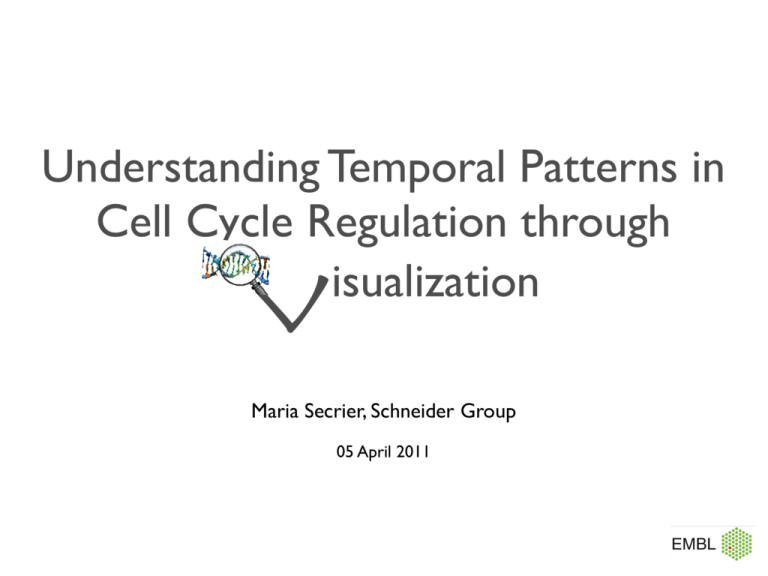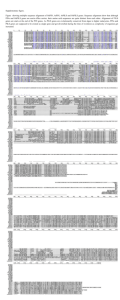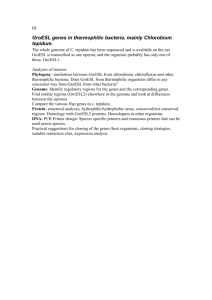Maria Secrier - the Rostlab!
advertisement

Understanding Temporal Patterns in Cell Cycle Regulation through isualization V Maria Secrier, Schneider Group 05 April 2011 Biological processes are dynamic! • Time: a bottleneck in systems biology ( © John Kyrk ) • How to efficiently visualize time course data? Ex: gene expression, knockdown experiments etc. http://www.visualcomplexity.com/vc/ Cell cycle regulation: inference of temporal patterns from knockdown effects siRNA mediated gene silencing (http://www.genengnews.com/gen-articles/next-generation-rna-interference/1321/) The Mitocheck Project (Neumann et al., Nature, 2010) Morphological classes (Neumann et al., Nature, 2010) Looking at phenotypic transitions within populations of cells Time Gene kif11 Phenotype 0 1 ... 91 mitotic delay 0.223 0.437 ... 0.014 binuclear 0.437 0.324 ... 0.000 polylobed 0.129 0.034 ... 0.954 ..... Binuclear aurkb Mitotic Delay Polylobed mitotic delay 0.436 0.428 ... 0.424 binuclear 0.722 0.134 ... 0.853 polylobed 0.274 0.543 ... 0.023 ..... Binuclear Polylobed How do populations of cells transition between phenotypes throughout the cell cycle? ? Binuclear Visualizing phenotypic transitions GO term network (from BiNGO) transitions between phenotypes number of knockdown events time phenotypes time slider choose GO representation 0.004 0.004 0.004 0.004 0.004 0.004 0.000 0.000 0.000 0.000 0.000 0.000 0 40 80 0 40 80 80 0 0 40 40 80 80 80 Grape 80 0 0 40 40 80 80 0 40 80 0 40 80 Large 80 0 40 80 0.004 40 0.000 0 0.004 80 0.000 40 0.004 0 0.000 0.004 40 0.000 0 0.004 80 0.000 40 0.004 0.004 0 0.000 0.000 80 0.004 40 40 0.000 0 0 0.004 80 0.000 Polylobed 0.004 80 0.000 0.004 0.004 40 0.004 0.000 0.004 0 0.004 0.000 0.000 80 0 40 80 0 40 80 0 40 80 0 40 80 0 40 80 Dynamic 0.004 40 80 40 0.000 0 40 0.000 0.004 0.004 80 0 0.004 80 0.000 0.000 0.000 Binuclear 0.004 0 40 80 0.000 0 40 0.000 40 80 0.004 0.004 0.004 0 0.004 0 40 80 0.000 0.000 0.000 0.000 0.000 0.000 0.000 0.000 0.000 0.004 0.004 0.004 0.004 0.004 0.004 Mitotic Delay 0.000 0 40 0.004 0.004 0.004 0 40 0.000 0.000 0.000 0 0.004 0.004 0.004 transition 0.000 0.000 0.000 TO phenotype Specific transitions: phen.A >> phen.B FROM phenotype 0 40 80 0 40 80 0 40 80 0 40 80 0 40 80 0 40 80 Apoptosis Are there gene knockdowns that cause (quasi-)simultaneous transitions? knockdown gene G1 ... ... knockdown gene G2 ... phen.A phen.B t = 27 ... ... phen.C phen.D t = 56 ... ... phen.E phen.F t = 78 Hypothesis: genes G1 and G2 could be activated together or act in the same pathway ... Genes quasi-synchronized in terms of transitions Transition 1 Transition 2 Transition 3 Phen.changes (1..7) adra2c | znf527 4|3 9 | 11 27 | 22 6>>2>>3>>2 aifm3 | aldoa 6|4 17 | 16 55 | 50 6>>3>>2>>3 aldoa | rpl27a 4|7 16 | 21 50|49 6>>3>>2>>3 aurkb | fam92b 18 | 20 37 | 35 54 | 53 1>>2>>3>>2 bahcc1 | fam112a 4|5 32 | 31 78 | 83 6>>3>>2>>3 bahcc1 | sap30bp 4|6 32 | 33 78 | 81 6>>3>>2>>3 dock2 | lrp1 10 | 10 18 | 16 65 | 69 6>>3>>2>>3 dock2 | vdac4 10 | 15 65 | 67 84 | 87 6>>3,2>>3>>2 ela3b | proc 17 | 17 24 | 24 33 | 36 6>>3>>2>>3 fam112a | sap30bp 5|6 31 | 33 83 | 81 6>>3>>2>>3 fam112a | spatc1 5|4 31 | 30 83 | 88 6>>3>>2>>3 fanci | vcx 17 | 18 36 | 38 57 | 56 3>>2>>3>>2 ky | slc2a8 10 | 5 11 | 16 35 | 38 5>>3>>2>>3 ky | znf664 4|4 10 | 9 11 | 11 7>>5>>3>>2 leprot | rpl27a 5|7 17 | 21 44 | 49 6>>3>>2>>3 mfsd4 | ncoa6 9|5 33 | 33 48 | 53 5>>3>>2>>3 ntn21 | sf3b5 6|4 12 |17 82 | 86 6>>3>>2>>7 q8na17_human | rhot2 9|7 56 | 57 83 | 81 6>>2>>3>>2 sez612 | trmu 10 | 5 11 | 7 87 | 87 6>>3>>2>>3 wbp2nl | znf575 3|4 7|5 75 | 70 6>>3>>2>>3 Genes causing quasi-simultaneous phenotypic transitions: network of potentially synchronous activations bahcc1 slc2a8 aifm3 ky aldoa znf664 fam112a spatc1 sap30bp rpl27a leprot znf527 vdac4 wbp2nl sez612 trmu q8na17_human rhot2 adra2c znf575 dock2 lrp1 sf3b5 mfsd4 fanci cela3b vcx aurkb proc ntn21 ncoa6 fam92b Genes causing quasi-simultaneous phenotypic transitions: network of potentially synchronous activations coexpression colocalization physical interaction other shared protein domains potential synchronous activation wbp2nl lrp1 vdac4 znf575 dock2 spatc1 znf664 ncoa6 sf3b5 leprot ntn21 fam112a rpl27a mfsd4 ky sez6l2 sap30bp bahcc1 aldoa aifm3 slc2a8 rhot2 q8na17_human cela3b vcx aurkb proc trmu adra2c fanci fam92b znf527 sez612 Gene-drug-disease maps in the cell cycle context Gene-disease associations (diseases mapped from OMIM Morbid Map) Cell cycle regulation: an evolutionary perspective How does the human ortholog landscape map to the cell cycle events ? P.troglodytes H.sapiens F.catus M.fuliginosus (Gauthier et al, NAR 2009) How does cell cycle regulation occur for different organisms? Which are the most conserved cell cycle sub-phases? Which temporal events contain most novel (i.e. least conserved) genes? no. of conserved genes at time point Which temporal events contain most novel (i.e. least conserved) genes? no. of conserved genes at time point Which temporal events contain most novel (i.e. least conserved) genes? no. of conserved genes at time point Time-point conservation of genes that peak throughout the cell cycle -1: no genes peaking at that time point Time-point conservation of genes that peak throughout the cell cycle: farther species removed -1: no genes peaking at that time point time Time-point conservation of genes that peak throughout the cell cycle: identifying not-so-well-conserved time point-peaking genes t27 - least conserved t60-64 -1: no genes peaking at that time point 1h 4h 11 h time 8h H.sapiens G1 0 t51 S 45 G2 M 80 96 100 Visualizing genetic variation in a phenotypic context •susceptibility to disease •drug response •reaction to environmental factors (©Jane Ades, NHGRI) Experiment setup BY gene expression genotyping phenotypic responses to small molecules RT Genetic variation and phenotypic plasticity Genetic variation and phenotypic plasticity positive phenotype peaks above defined threshold parent strains genes with highest expression change negative phenotype stress factors Acknowledgements Schneider Group Reinhard Schneider Venkata Satagopam Sean O’Donoghue Salvador Santiago Afshin Khan Janos Binder TAC members Toby Gibson Lars Steinmetz Rob Russell Ellenberg Group Huber Group Dudley Group (ISB) Jean-Karim Hériché Wolfgang Huber Patrick May Thomas Walter Gregoire Pau






